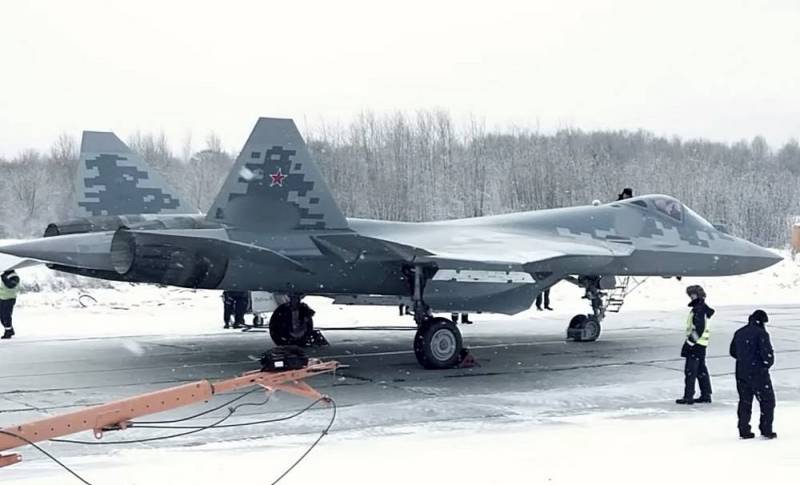What promising mini-drones could be in service with the Su-57 fighter
One of the most interesting News from the recent domestic military-industrial complex - this is information that the fifth-generation fighter Su-57 will receive a whole family of reconnaissance and strike mini-drones in the form of additional weapons. If this is indeed the case, then the Russian heavy fighter will take a real step towards the next, sixth generation.
Faithful wingman
It is quite obvious that this accelerated evolution of the Su-57 is a response to the challenges received during the SVO. Due to the oversaturation of the Armed Forces of Ukraine with air defense systems, even stealthy fifth-generation Russian fighters do not risk operating freely in the skies over Ukraine due to the threat of losing a technically very complex and expensive aircraft, which is available in the Russian Aerospace Forces in extremely limited quantities.
The response was the widespread use of Iranian-made Geranium-type kamikaze drones, which are used to overload the Ukrainian air defense/missile defense system, clearing the way for more powerful and expensive Russian missiles. Informed source from RIA Novosti commented the idea of equipping the Su-57 with a swarm of mini-UAVs as follows:
Drones dropped in dozens of units by a group from an airplane will allow fighters to break through enemy air defenses, overloading its information channels and due to a concentrated strike on its systems with both drones and weapons from fighters.
Sounds more than reasonable. The heavy Russian fighter is a formidable weapon in its own right, carrying a wide range of aircraft ammunition: from air-launched cruise missiles to glide bombs. The only thing that limits its combat capabilities is the acute shortage of AWACS aircraft in the Russian Aerospace Forces that could provide the Su-57 with target designation data. A swarm of drones could solve two problems at once - with target designation and breaking through the enemy air defense/missile defense system.
But what kind of UAVs will these be?
Unmanned swarm
Ideally, the scheme for using a UAV swarm is as follows. The first wave is UAVs: “targets”, reconnaissance-attack and anti-radar, which force enemy air defense systems to activate, wasting ammunition on interception, and hit their radars, as well as the anti-aircraft systems themselves. In the second wave are unmanned fighters, firing missiles and gliding bombs. And only in the third are manned Su-57s, which, loitering at a safe distance, exercise control and coordination, finishing off everything that could survive.
In this form, the Russian fighter is truly approaching the next, sixth generation. The first step was taken when the interaction between the Su-57 and the Okhotnik heavy UAV, which acted as a “faithful wingman,” was being tested. It was assumed that the S-70 would be used either for reconnaissance and target designation, or for air strikes, controlled remotely from an aircraft. True, there was one important nuance that the media often forgot to mention.
The Su-57 is a supersonic fighter, and the unmanned Okhotnik, created according to the “flying wing” design, can only reach subsonic speed. That is, they can fly together in a beautiful formation only during tests, but not in real combat conditions. In addition, the S-70 so far exists in single copies, they are expensive, and therefore it is scary to lose them without showing a significant result. In this regard, a fair question arises - what performance characteristics should the mini-drones that will be introduced into the Su-57 armament have? An informed source puts it this way:
The Su-57 will be able to carry such mini-drones for various purposes on an external sling and in the intra-fuselage compartment, and then drop them in the air. It is planned that the fighter will be able to launch several drones at once and control this group of drones.
In other words, these will be some relatively compact reconnaissance-strike drones that can be hung on a fighter or placed inside the fuselage. You shouldn’t expect them to be able to fly UAVs in formation behind a supersonic fighter. What they will look like, due to the acute lack of information, one can only guess. However, it seems that it will be something like an enlarged air-launched Lancet.
If follow the path Israeli company UVision and equip the drone with a gasoline engine instead of an electric one, like the HERO-1250, then the flight range will increase to 200 km, and the loitering time will increase to 10 hours. In addition, on the basis of this attack drone, a purely reconnaissance version can be made if, instead of the warhead, a parachute landing system is installed, turning the UAV into a reusable one. This is more rational than creating a technically complex drone that can be returned to a fighter.
In addition, the fighter will be able to interact with drones launched in advance from the ground, strike, anti-radar and “targets”. By using such tactics, the problem of differences in aircraft speeds will be leveled out. The real breakthrough will be the creation of an unmanned version of the light single-engine fighter of the fifth generation Su-75, which will be the most effective "faithful wingman" for the heavy Su-57.

Information